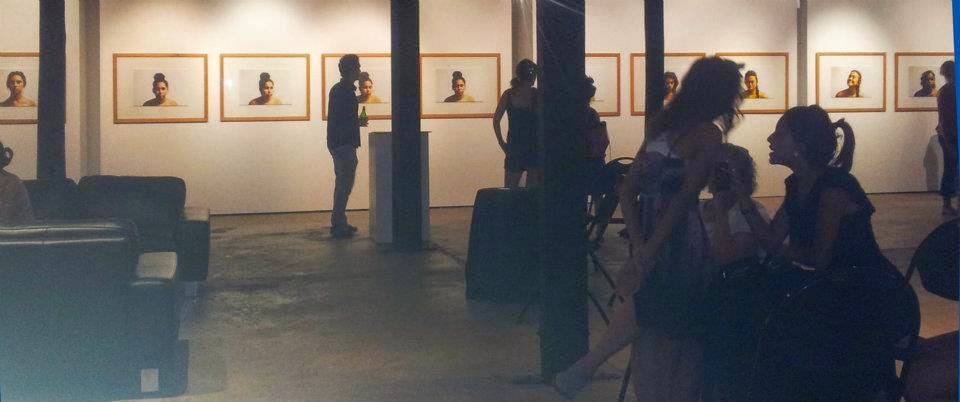I was honoured in 2012, to be invited to open Shannon Brett’s I Didn’t Get To Cry Til Now exhibition at the Tanks, in Cairns.
To start I would like first to acknowledge the Traditional Owners, the Yidinji people, and acknowledge their ongoing sovereignty of the land and sea. I would also like to acknowledge the people here today. I’m from down south, from Brisbane. I’ve known Shannon for a few years now from when she was a student at Queensland College of Art doing the Bachelor of Contemporary Australian Indigenous Art. And I’m very humbled to be here to speak about the exhibition and to introduce Shannon’s work to you all.
It’s been a long time since I was a teenager and my early twenties were literally twenty years ago. And in reading this body of work, I’m conscious that it’s primary audience is not me, but my young daughter, my nieces and other young Aboriginal and Torres Strait Islander women in this community and in communities around the country.
You see, despite the fact that women have come yes indeed come along way, and Aboriginal and Torres Strait Islander women (and men) have come along way, there is still so much work to be done.
As a parent, I worry about the messages that my daughter is consistently being sent. The dichotomous messages about how to behave, what to expect. If we look at images of young women online – so much of it is about exhibitionism for a known or unknown audience, it’s all accentuated cleavages and pouty fish lips. On television, there are consistent messages that if you’re not skinny you don’t deserve nor will you find love. High profile journalists and media sources tell our young people that on the one hand, they’re being raised in the most dysfunctional families in the country, and yet on the other, if they get too much of an education they could end up not being authentic enough to live and work within their own communities.
I also worry for my three teenage sons, what messages are being sent to them about how women behave, about what women expect, and about how women wish to be treated. There are so many messages – both racist and sexist – that seem only designed to keep young people confused and mentally battered.
bell hooks has labelled this type of representation as being part of the project of White Supremacist Capitalist Patriarchy. That, is that “the interlocking systems of domination – of race, sexism, misogyny, homophobia – that define our reality”
Patricia Grace, a Maori writer has argued that books (and the media) can be dangerous to young Indigenous people, as they do not reinforce our values, actions, customs, culture and identity,
- when they tell us only about others they are saying we don’t exist; (how many young Aboriginal and Torres Strait Islander women appear regularly in as three dimensional characters across Australian media?)
- they may be writing about us but are writing things which are untrue; (how regularly do media outlets across the country create and re-create racist narratives about Aboriginal and Torres Strait Islander people)
- when they are writing about us but saying negative and insensitive things which tell us we are no good; (The Australian newspaper anyone?)
To me Shannon’s exhibition,
I Didn’t Get To Cry Till Now, is an attempt to speak back to the representation and stereotype Aboriginal woman. She demonstrates and makes explicit, that behind the stereotype, behind the narrative, there is a person, a human being. She brings forth the racialised and gendered self that is rendered Invisible by the
White Supremacist Capitalist Patriarchial project that is colonised Australia.
Mary Graham, a Kombamerri Elder and philosopher has talked in her work about the reflective and questing Aboriginal mind. One that is in tune with community and that seeks to understand ourselves and maintain relationships with others. The questing mind, to be on a quest, a challenge, to question, to think critically. This resonates with me, when I see Shannon’s work. Her work is about her, and about the women and men in her life.
Shannon isn’t the only one, she’s not the first. Others have gone before her – Destiny Deacon, Fiona Foley, and Dianne Jones, and many others. Shannon continues their legacy as story tellers who speak back to power, who represent their own families and communities, who gives voice to those who are rendered voiceless in the ongoing colonisation of this land.
I’ve known a few artists at the start of their careers and watched as they’ve gone from being emerging to established artists. That journey can take over a decade. But I have no doubt, that Shannon with the support of her family and community, will continue to grow from strength to strength. Ladies and Gentleman, I would like to introduce to you Ms Shannon Brett …
Thankyou.

'Art to help us understand ourselves and our relationship with others…'
A brilliant intro. Thank you too, for reminding me about the Bachelor of indig Art course.
Have just finished 8 week place with a UQ Matsiti participant. We had three pre-service students – across humanities. Excited for the future. x 😀
Thanks Flora. Shannon is an excellent artist – smart, talented and brave. She's not afraid to try new things. And yes, we all love CAIA (the Bachelor of Contemporary Australian Art). The future is exciting – so much more work to be done. As always, thank you for the comment.
Ancient Rock Art found in some of the remotest parts of Australia date back 30,000 to 40,000 years. However, as a saleable commodity, this form of Aboriginal Art has only really been available since past few decades.